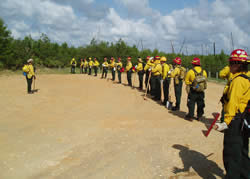
National Fire Plan Success Story
Training Lowers Firefighting Costs
Puerto Rico
National Fire Plan - Firefighting
2009

Firefighters line-up as part of the field portion of their basic wildland fire training at Cabo Rojo National Wildlife Refuge in Puerto Rico. Photo by U.S. Fish and Wildlife Service.
In January 2009, firefighters from the U.S. Fish and Wildlife Service in Puerto Rico sponsored the seventh annual wildland fire-training academy for structural firefighters. The training has increased safety practices and helped lower firefighting costs in the Caribbean Islands by reducing the need for firefighters from the mainland in response to more than 25 wildfires that have occurred on Service lands here in the last 3 years.
“We started this program because we saw a need to train the structural firefighters and volunteers on safe wildland fire tactics since they help us with initial attack on wildfires,” said Service firefighter James Padilla. The Service has an agreement with the Puerto Rico, a U.S. territory, to assist on fires.
The academy has qualified over 145 people to meet national standards as wildland firefighters. Many of the same students return to the training each year, held at the Cabo Rojo National Wildlife Refuge headquarters in southwest Puerto Rico.
The three-week wildland academy helps qualify structural firefighters to assist with local fighting fire on Service lands. Once qualified, they can also to be dispatched as needed anywhere else in the United States.
The training effort began in 2003 with basic wildland fire training for a few firefighters. Since then, the training has evolved into an annual fire training offering introductory curriculum for wildland firefighters as well as mid-level supervisory courses.